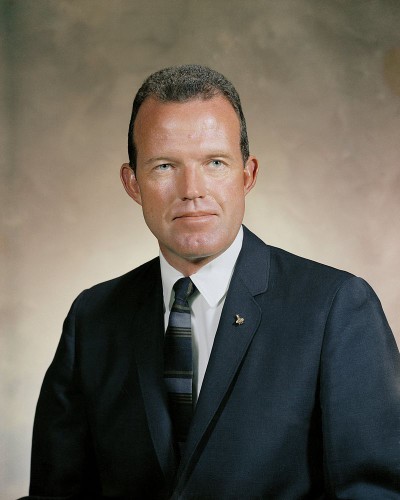Gordon Cooper (Leroy Gordon Cooper)

While at Edwards, Gordon Cooper was intrigued to read an announcement saying that a contract had been awarded to McDonnell Aircraft in St. Louis, Missouri, to build a space capsule. Shortly after this he was called to Washington, D.C., for a NASA briefing on Project Mercury and the part astronauts would play in it. Cooper went through the selection process with the other 109 pilots and was not surprised when he was accepted as the youngest of the first seven American astronauts. Each of the Mercury astronauts was assigned to a different portion of the project along with other special assignments. Cooper specialized in the Redstone rocket (and developed a personal survival knife, the Model 17 “Astro” from Randall Made Knives, for astronauts to carry). He also chaired the Emergency Egress Committee, responsible for working out emergency launch pad procedures for escape. Cooper served as capsule communicator (CAPCOM) for Alan Shepard’s first sub-orbital spaceflight in Mercury-Redstone 3 (Freedom 7) and Scott Carpenter’s flight on Mercury-Atlas 7 (Aurora 7). He was backup pilot for Wally Schirra in Mercury-Atlas 8 (Sigma 7).
Gordon Cooper was launched into space on May 15, 1963, aboard the Mercury-Atlas 9 (Faith 7) spacecraft, the last Mercury mission. He orbited the Earth 22 times and logged more time in space than all five previous Mercury astronauts combined—34 hours, 19 minutes and 49 seconds—traveling 546,167 miles (878,971 km) at 17,547 mph (28,239 km/h), pulling a maximum of 7.6 g (74.48 m/s²). Cooper achieved an altitude of 165.9 statute miles (267 km) at apogee. He was the first American astronaut to sleep not only in orbit but on the launch pad during a countdown. Like all Mercury flights, Faith 7 was designed for fully automatic control, a controversial engineering decision which in many ways reduced the role of an astronaut to that of a passenger, and prompted Chuck Yeager to describe Mercury astronauts as “Spam in a can”. Toward the end of the Faith 7 flight there were mission-threatening technical problems. During the 19th orbit, the capsule had a power failure. Carbon dioxide levels began rising, and the cabin temperature jumped to over 100 degrees Fahrenheit (38°C). Gordon Cooper turned to his understanding of star patterns, took manual control of the tiny capsule and successfully estimated the correct pitch for re-entry into the atmosphere. Some precision was needed in the calculation, since if the capsule came in too steep, g-forces would be too large, and if its trajectory were too shallow, it would shoot out of the atmosphere again, back into space. Cooper drew lines on the capsule window to help him check his orientation before firing the re-entry rockets. “So I used my wrist watch for time,” he later recalled, “my eyeballs out the window for attitude. Then I fired my retrorockets at the right time and landed right by the carrier.” Cooper’s cool-headed performance and piloting skills led to a basic rethinking of design philosophy for later space missions.
Two years later (August 21, 1965), Gordon Cooper flew as Command Pilot of Gemini 5 on an eight-day, 120-orbit mission with Pete Conrad. The two astronauts established a new space endurance record by traveling a distance of 3,312,993 miles (5,331,745 km) in 190 hours and 56 minutes, showing that astronauts could survive in space for the length of time necessary to go from the Earth to the Moon and back. Cooper was the first astronaut to make a second orbital flight and later served as backup Command Pilot for Gemini 12. Gordon Cooper was selected as backup Commander for the May 1969 Apollo 10 mission. He hoped this placed him in position as Commander of Apollo 13, according to the usual crew rotation procedure established by the Flight Crew Operations Director – grounded fellow Mercury astronaut Deke Slayton. However, by May 1969, when another grounded Mercury astronaut, Slayton’s assistant Alan Shepard was returned to flight status, Slayton replaced Cooper with Shepard as Commander of this crew, which was then re-assigned to Apollo 14 in order to give Shepard more time to train. Loss of this command placed Cooper farther down the flight rotation, meaning he would not fly until one of the later flights, if ever. Gordon Cooper developed Parkinson’s disease and died at age 77 from heart failure at his home in Ventura, California, on October 4, 2004. His death occurred on the 47th anniversary of the Sputnik 1 launch and the same day that SpaceShipOne made its second official qualifying flight.
Born
- March, 06, 1927
- USA
- Shawnee, Oklahoma
Died
- October, 04, 2004
- USA
- Ventura, California
Cause of Death
- Parkinson's disease
Other
- Cremated



